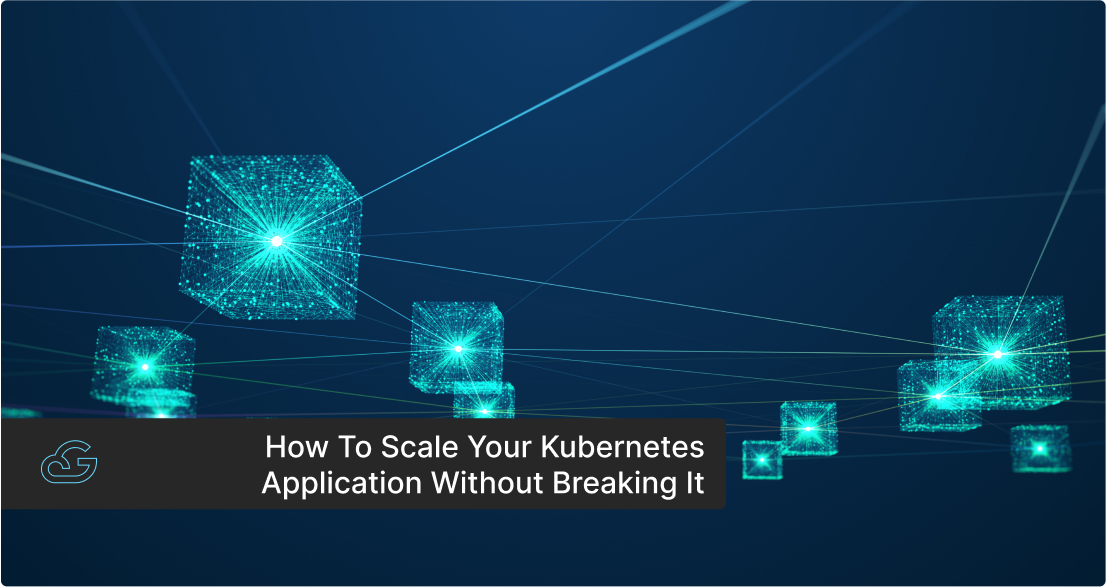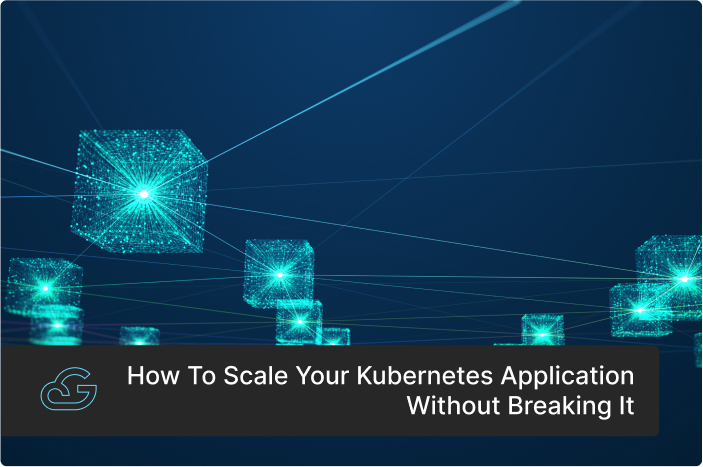Blogs / Kubernetes
How to Scale Your Kubernetes Application Without Breaking It?
By
Harish K K
Posted: February 14, 2024
• 7 min 56 sec read
In modern application development, the adoption of microservices has become standard practice, largely driven by the efficiency and adaptability of containers. Docker has played a pivotal role in this paradigm shift, simplifying the process of code development and deployment of containerized applications. However, as organizations increasingly embrace this decentralized architectural approach, the necessity for a robust and dependable orchestrator becomes crucial. This is where Kubernetes comes into play – serving as a container orchestrator capable of managing Docker containers across varying scales with remarkable productivity.
However, as the Kubernetes app grows, handling increased user demand and workload changes has become the next big concern for many businesses. This calls for strategically scaling Kubernetes applications to ensure optimal performance and continued user satisfaction. This blog breaks down essential scaling techniques and best practices for your Kubernetes app while maintaining top-notch performance and a smooth user experience.
Why should you use Kubernetes?
Kubernetes removes the complexities of distributed application architectural systems by offering easier management and orchestration of the underlying infrastructure. Here are the key benefits and reasonings behind the adoption of Kubernetes for your applications.
-
Service Discovery and Load Balancing: Kubernetes facilitates stable deployments by intelligently finding services and distributing network traffic. This ensures efficient load balancing across containers.
-
Storage Orchestration: With Kubernetes, you can easily integrate various storage systems, including local and public cloud providers, streamlining storage management.
-
Automated Rollouts and Rollbacks: Kubernetes allows you to define the desired state of your deployment (replica count, container image, resource requests/limits) and then automatically initiates the rollout by creating new pods with the updated configuration and scaling down old pods. If a rollout encounters issues, Kubernetes can automatically roll back to the previous version, minimizing downtime and data loss.
-
Automatic Bin Packing: Kubernetes optimizes resource utilization by intelligently allocating containers across nodes based on defined resource requirements.
-
Self-Healing Capabilities: Kubernetes actively monitors and manages container health, automatically restarting or replacing failed instances to ensure continuous operation and availability.
-
Secret and Configuration Management: Kubernetes allows for secure storage and deployment of secrets and application configurations without image rebuilding or exposing critical data.
What does Application Scaling on Kubernetes mean?
Application scaling on Kubernetes refers to the ability to dynamically adjust resource allocation based on demand. This process involves increasing or decreasing the number of instances (pods) running your application or adjusting the resources allocated to each pod. Scaling ensures that your application can handle varying levels of traffic or workload efficiently without experiencing performance issues or downtime.
Below are some real-life applications where Kubernetes scaling has proven its efficiency and potential.
-
E-commerce platforms often experience fluctuating traffic levels, especially during sales events or holidays. For example, Flipkart uses Kubernetes auto-scaling capabilities to dynamically allocate resources based on traffic demand. During events like the Big Billion Day or End of Season Sale, Kubernetes helps Flipkart handle surges in traffic, process orders efficiently, and maintain high availability.
-
Video-on-demand platforms or live streaming applications require robust infrastructure to handle high volumes of concurrent users. Spotify, a popular music streaming platform, experiences a significant increase in traffic during peak hours. The service leverages Kubernetes scaling to automatically add or remove resources based on demand.
-
Transportation and ride-sharing platforms like Uber employ Kubernetes scaling to dynamically scale their backend systems to handle the increased demand for ride requests. This ensures that users can quickly find available drivers and book rides without experiencing delays.
When should you use Kubernetes Scaling?
Determining when to leverage Kubernetes scaling depends on various factors inherent to your project requirements and infrastructure. Here’s a breakdown of scenarios where Kubernetes is an ideal choice, along with real-life applications.
- When your business demands highly scalable infrastructure.
- When your application experiences fluctuating traffic.
- When your workload requirements vary over time.
- When your applications need uninterrupted service availability.
- When you want to maximize resource efficiency in your infrastructure.
Factors to Consider Before Implementing Kubernetes Application Scaling
Before implementing different Kubernetes scaling mechanisms on your applications, it's imperative to analyze your scalability requirements. By evaluating factors like user growth, performance bottlenecks, and resource demands, you can create an effective scaling strategy for your Kubernetes applications. Following are the steps to be considered in this regard.
- Evaluate the pace at which your user base is expanding to anticipate future scalability demands.
- Identify areas within your application experiencing performance bottlenecks, including user interactions and node resource utilization, to address them proactively during scaling efforts.
- Determine if specific components of your application require disproportionate resources to formulate resource allocation strategies for efficient scaling.
- Utilize the autoscaling functionality offered by cloud providers, leveraging resource limits to automate scaling processes based on predefined metrics thresholds.
- Ensure the resilience of mission-critical applications by maintaining a buffer percentage of pod replicas and resources. This helps to mitigate the risk of service disruptions and safeguard business operations.
How to Scale Your Kubernetes Application Without Breaking it?
With autoscaling, Kubernetes applications can seamlessly respond to workload changes without compromising performance or stability. The common strategies for scaling applications within Kubernetes environments include the following:
-
Horizontal Pod Autoscaler (HPA)
- Dynamically scales the number of pods based on predefined metrics like CPU usage, memory usage, or custom metrics.
- Users define resource requests and limits for pods and establish target metrics for HPA, allowing for customized scaling criteria.
- Automatically generates new replicas of the deployment to handle increased workload.
- Adapts to changing workloads to maintain desired performance levels.
- Applicable for both stateless applications and stateful workloads, providing flexibility in workload management.
- Ensure accurate scaling decisions by configuring resource requests for all pods. HPA relies on CPU utilization values relative to pod resource requests, ensuring data accuracy across all containers.
- Prioritize custom metrics over external metrics whenever feasible. Custom metrics APIs pose lower security risks than external metrics APIs, reducing exposure to potential compromises.
-
Vertical Pod Autoscaler (VPA)
- Analyzes historical and current resource usage to recommend optimal CPU and memory requests and limits for pods.
- Scales resources of individual pods, offering more granular control compared to HPA.
- Prevents under-provisioning and optimizes resource allocation to individual pods.
- Reduces the need for frequent pod creation and deletion by adjusting existing resources.
- Reduces wasted resources and potentially lowers cloud costs.
- Works effectively alongside HPAs for a comprehensive scaling strategy.
- Avoid simultaneous use of HPA and VPA, as they are incompatible. Opt for either custom or external metrics for HPA configurations to prevent conflicts.
- Integrate VPA with Cluster Autoscaler to prevent resource pressure. Cluster Autoscaler can dynamically spin up new nodes to accommodate resource requests recommended by VPA, preventing pods from going into a pending state.
-
Cluster Autoscaler
- Automatically adds or removes nodes in your cluster based on CPU, memory, or custom metric utilization.
- Works with various cloud providers like AWS, Azure, GCP, and on-premises deployments.
- Ensures your cluster has enough resources to handle the workload while avoiding unnecessary costs from idle nodes.
- Ensure adequate resource allocation for the Cluster Autoscaler pod by defining a minimum of one CPU for its resource requests. This ensures responsiveness and proper functioning of the Cluster Autoscaler.
- Maintain defined resource requests for all pods to enable accurate decision-making by the Cluster Autoscaler. It relies on pod statuses and node utilization, requiring precise calculations to function effectively.
A Horizontal Pod Autoscaler (HPA) is a Kubernetes resource that automatically adjusts the number of pods in a Deployment, ReplicaSet, or StatefulSet based on observed metrics like CPU utilization and traffic demands. This helps ensure your application has the appropriate number of resources to handle changing demands, optimizing efficiency and performance.
Key features
Best Practices for Implementing HPA
A Vertical Pod Autoscaler (VPA) is a Kubernetes resource that dynamically adjusts the CPU and memory requests and limits of individual pods within a Deployment, ReplicaSet, or StatefulSet. This differs from a Horizontal Pod Autoscaler (HPA), which adjusts the number of pods. VPAs are still under active development, with newer features and improvements being added regularly. HPAs are often used in conjunction with HPAs to achieve a complete workload scaling solution.
Key features
Best Practices for Implementing VPA
The Cluster Autoscaler (CA) is a Kubernetes component that automatically manages the horizontal scaling of your entire Kubernetes cluster. Unlike Horizontal Pod Autoscalers (HPAs), which adjust pods within a specific deployment, the CA focuses on adjusting the number of nodes in your cluster based on the overall resource needs of all your applications.
Key features
Best Practices for Implementing Cluster Autoscaler
Challenges of Scaling Your Applications Without Kubernetes
Scaling applications without Kubernetes can present several challenges, especially as the complexity and demands of your infrastructure grow. This could impact the agility and overall efficiency of the application. Some of the key challenges you might encounter are the following:
Requires Manual Scaling
- Manually adjusting resources like servers or containers requires constant monitoring and intervention, which is time-consuming. This process is error-prone and increases operational overheads.
- It's difficult to predict future resource needs accurately, leading to over-provisioning (wasting resources) or under-provisioning (causing performance bottlenecks).
- Reacting to sudden traffic spikes or dips takes manual effort, potentially leading to outages or performance degradation before resources are adjusted.
Limited Visibility and Management
- Managing various scaling factors like replicas, CPU/memory allocation, and network resources across different systems becomes complex and fragmented.
- Identifying the root cause of performance issues requires digging through individual servers or containers. It will affect quick response and troubleshooting.
- Manually monitoring application health can be tedious and unreliable, increasing the risk of undetected failures.
Scalability Limitations
- Scaling individual VMs vertically has limitations based on hardware capacity, making scaling beyond a certain point difficult.
- Manually adding or removing VMs for horizontal scaling involves provisioning, configuration, and network management, increasing complexity and cost.
Get Expert Support with Gsoft’s Managed Kubernetes Services
Scaling your Kubernetes application without disrupting performance is a complex task. At Gsoft, we take the stress out of scaling with our Managed Kubernetes Services which provide:
-
Expert Guidance: Our team of experts will handle all the heavy lifting, from infrastructure management to autoscaling configuration, ensuring your application runs smoothly and efficiently. They will assess your application's scalability requirements and implement the most efficient strategies.
-
Automated scaling tools: We leverage advanced tools to automatically adjust resources based on your application's needs, preventing both over-provisioning and performance bottlenecks.
-
24/7 Support: Our dedicated support team is available round the clock to address any issues and provide timely assistance, ensuring minimal disruption to your operations.
Ready to scale your Kubernetes application with confidence? Reach out to us today and learn more about our Kubernetes Consulting Services. www.gsoftcomm.net


Get Know More About Our Services and Products
Reach to us if you have any queries on any of our products or Services.











